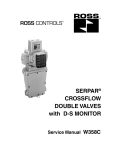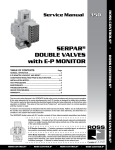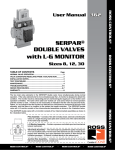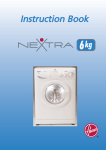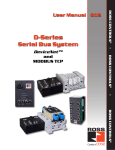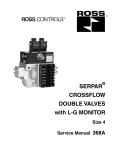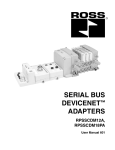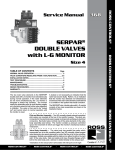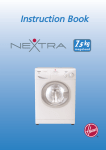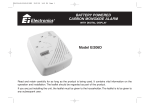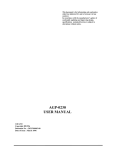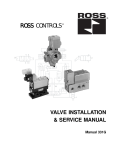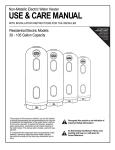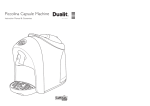Download 5 - Omni Industrial, Inc.
Transcript
ROSS CONTROLS® ® SERPAR CROSSFLOW DOUBLE VALVES with E-P MONITOR Service Manual 350D TABLE OF CONTENTS Page INTRODUCTION..........................................................................................................2 VALVE OPERATION Normal Operation...............................................................................................3 E-P Monitor Lockout and Reset.........................................................................4 Conditions Resulting from a Malfunction........................................................5 INSTALLATION NOTES...............................................................................................6 TEST PROCEDURE....................................................................................................6 MAINTENANCE...........................................................................................................7 TROUBLESHOOTING.............................................................................................7-8 REPAIR PROCEDURES.........................................................................................9-11 WARRANTY................................................................................................................12 INTRODUCTION The two main valve elements in the SERPAR® Crossflow double valve move simultaneously during normal operation. If the valve elements fail to move simultaneously, the E-P monitor is designed to detect this condition. The monitor reacts by disconnecting the electrical supply to the pilot valve solenoids, so that further valve operation is inhibited. The valve is then said to be “locked out” and cannot return to normal operation until the monitor is reset. A lockout is not necessarily an indication that the valve has become faulty. Rather, it is an indication that the monitor has detected non-simultaneous movement of the main valve elements, and that there is a condition in the system that needs correction. The SERPAR® Crossflow double valve with E-P monitor consists of three interconnected assemblies (see below). Pilot Assembly – Consists of two 3/2 normally closed, solenoid controlled pilot valves in a single housing. Each pilot valve controls one of the valve elements in the valve body assembly. Valve Body Assembly – The valve body has parallel flow paths including two in-to-out crossflow paths. The two main valve elements are 3/2 normally closed poppet valve elements, plus spool elements that control air flow through the crossflow passages. A silencer is bolted directly to the exhaust port. E-P Monitor Assembly – Contains a pressure controlled spool, an electrical two-position momentary latching switch, and a reset solenoid. ROSS CONTROLS® NORMAL VALVE OPERATION Becoming thoroughly familiar with the functions of the SERPAR® Crossflow double valve and its E-P monitor will help in analyzing lockouts and finding their causes. The next few pages should be studied carefully to get an understanding of both the normal valve functioning and what happens when a malfunction occurs. F F B CONDITIONS AT START 4 A 3 2 Inlet air is blocked from the outlet port by two normally closed valve elements A and B (see Figure 1). The outlet port 2 is connected to the exhaust port 3. Pilot supply air comes from the inlet port 1, and is carried via passage 4 to the two 3/2 normally closed, solenoid controlled pilot valves F. 1 SOLENOIDS ENERGIZED Simultaneously energizing the two solenoids “a” and “b” (Figure 2) causes the two pilot poppets E to shift. This closes the pilot exhaust passages and opens the pilot supply passages. Pilot air can then go to the main valve pistons J via passages 5. Pressure on the pistons shifts the main valve elements. This closes off the exhaust port 3, and connects the inlet port 1 to the outlet port 2 via the crossflow passages 10 and 11. With the main valve inlet poppets U and V open, the monitoring passages 6 are open to inlet pressure. This pressure is directed to both ends of spool W. Because these monitoring signal pressures are equal, spool W remains in its center position. Note that the valve elements must move simultaneously in order for the E-P spool to remain in its pressure balanced center position. Figure 1 – Solenoids Not Energized b a E 5 E 5 J J 3 2 SOLENOIDS DE-ENERGIZED Simultaneously de-energizing solenoids “a” and “b” allows the two pilot poppets E to return to their normally closed positions. Pilot pressure on the main valve pistons J is exhausted through exhaust port 3 via internal exhaust passages (not shown). The main valve piston poppets J, and inlet poppets U and V return to their normal de-actuated positions. Inlet air is again blocked from outlet port 2 by poppets U and V. Pressure at outlet port 2, at the ends of spool W, and in the monitoring passages 6 is exhausted through exhaust port 3. This completes the normal operating cycle, and the valve has returned to the Conditions at Start described above. 1 11 V 6 6 10 U W Figure 2 – Solenoids Energized www.rosscontrols.com E-P MONITOR LOCKOUT AND RESET C K W M T L M 6 6 Figure 3 – Horizontal Cross Section of E-P Monitor E-P MONITORING and LOCKOUT the valve function) inlet pressure via passage 6 will be applied to one end of the spool sooner than at the other end. When the pressure differential exceeds 2 bar (30 psi) the pressure imbalance causes the spool to shift, tripping switch actuator pin K. This shifts switch L and breaks the circuit to the pilot solenoids (see Figure 5 below). With the pilot solenoids de-energized, the pilot valves close, and air pressure on the pistons of the main valve elements is exhausted. The main valve elements then return to their de-actuated positions, and air pressure on the ends of the E-P spool is exhausted. When switch L is shifted, the valve is said to be “locked out,” and operation cannot be resumed until the E-P monitor is reset. Note also (Figure 5) that terminals 3 and 7 have been connected. This allows a panel light, bell, or other electrical device to be wired through terminals 3 and 7 to serve as a lockout indicator. GROUND HOT The heart of the E-P monitor is its spool W and associated switch L (see Figure 3). The spool is kept in its normal position by centering springs M. Switch L is a two-position momentary latching switch, wired as shown in Figure 4 below. In its normal position it completes the electrical 1 2 3 4 5 6 7 8 9 circuit to the pilot solenoids through terminals 3 and 4. GROUND a b HOT L 1 2 3 4 5 6 7 8 9 C Figure 5 – Wiring Diagram with Pilot Solenoid Circuit Open a b RESETTING THE E-P MONITOR L C Figure 4 – Wiring Diagram with Pilot Solenoid Circuit Completed When the valve is installed, the “hot” line is connected to terminal 3, and the ground is connected to terminal 1. Pilot solenoids “a” and “b” are factory wired in parallel through switch L. With switch L in its normal position, the pilot solenoids are energized when an external switch in the “hot” line is closed. The E-P monitor is designed to respond to nonsimultaneous movement of the main valve elements, and to render the valve inoperable when such movement occurs. Therefore, if one of the main valve elements opens before the other (due to a malfunction within the valve or some other element in the system which affects Caution: To avoid the potential for injury and to ensure that the equipment controlled by the valve does not begin operating immediately after resetting the E-P monitor, the electrical supply to the pilot solenoids must be turned off during the resetting process. Otherwise, the energized solenoids will actuate the valve as soon as the monitor is reset. After the pressure imbalance on the spool of the E-P monitor has been removed, the spool is returned by springs M to its normal center position. However, switch L remains in its shifted position and the valve remains locked out. The cause of the lockout must be corrected before resetting switch L and thereby allowing the valve to be actuated. Reset is accomplished by briefly energizing the reset solenoid C. IMPORTANT: Energize the reset solenoid only briefly. Prolonged energization of the reset solenoid can cause it to burnout. Thus the monitor can no longer be reset and the valve will remain locked out. ROSS CONTROLS® VALVE CONDITIONS RESULTING FROM A MALFUNCTION DURING A MALFUNCTION a b If conditions do not allow one of the main valve elements to be shifted, or do not allow one of the elements to return to its normally closed position upon de-actuation, we have the condition depicted in Figure 6 — one valve element closed and one open. Inlet air flowing past open poppet U and into crossflow passage 10 is substantially blocked by spool SB on valve element B. Although some air can pass around the spool SB, the amount is so small, and the exhausting capacity of the valve so large, that the pressure at outlet port 2 does not exceed two per cent of inlet pressure. At the same time, inlet air pressure to spool W via passages 6 will be delivered only from the open valve element A. The pressure delivered to the right end of the spool will cause it to shift to the left. In so doing, the spool will trip switch L. This will break the electrical circuit to the pilot solenoids “a” and “b” so that the valve is locked out. Further valve operation is inhibited, and normal valve operation cannot be resumed until the E-P monitor is reset. (See page 4 for important resetting procedures.) A B 3 2 1 10 U SB 6 W Figure 6 – Faulted Mode with One Valve Element Open and One Closed Note that the lockout described above also holds true when spool W is shifted in the opposite direction because of reversed positions of the main valve elements. a b FOLLOWING LOCKOUT E F E With the electrical circuit to pilot solenoids “a” and “b” kept open by switch L (see Figure 3), the pilot poppets E and the main inlet poppets U and V return to their normally closed positions (see Figure 7), and inlet pressure is completely blocked from the outlet port. However, if a valve element remains open or partially open, outlet pressure remains at two per cent or less of inlet pressure. This small outlet pressure is due to the blocking action of spools SA and SB plus the large exhausting capacity of the valve. When the inlet poppets U and V close after a lockout, monitoring air pressure is removed from spool W so that it is returned to its center position by springs M. However, this does not affect the position of the momentary latching switch L (see Figure 3). It keeps the electrical circuit to the pilot solenoids open so that further valve operation is inhibited. B A 3 2 1 SB SA V W M U M Figure 7 – E-P Spool Returned to Center Position After Breaking Circuit to Pilot Solenoids www.rosscontrols.com INSTALLATION NOTES Pneumatic equipment should be installed only by persons trained and experienced in the installation of pneumatic equipment. Air Lines. Before installing a ROSS double valve in an existing system, the air lines must be blown clean of all contaminants. Experience has shown that one of the leading causes of lockouts is foreign material from the air lines which becomes lodged in the valve. It is strongly recommended that an air filter be installed ahead of and close to the valve. ROSS recommends a 5-micron-rated filter. Valve Inlet 1. (See Figure 8.) DO NOT RESTRICT THE AIR SUPPLY. Any restriction of the air supply lines (for example, sharp bends or undersize lines) will reduce the speed with which the outlet volume is pressurized. See Inadequate Air Supply, page 9, for further discussion. Valve Outlet 2. For faster pressurizing and exhausting of the outlet volume put the valve close to the mechanism being operated. Also, any restriction in the outlet lines will reduce pressurizing and exhausting speeds. Valve Exhaust 3. DO NOT RESTRICT THE EXHAUST. Limiting the exhausting speed decreases an important safety feature of the double valve. During a malfunction in which only one of the valve elements has shifted, air escaping past the spool in the valve stem of the closed valve element (see Figure 6) must be quickly exhausted to keep outlet pressure at or below the design pressure of two per cent of inlet pressure. Therefore, use only a properly sized and designed silencer. Electrical Conduit Port 13. It is very important that the electrical supply be of the correct voltage and frequency. Solenoids are rated for continuous duty at 85% to 110 % of the voltage shown on the pilot housing. A supply voltage that does not fall within this range can cause nuisance lockouts or premature solenoid burnout. If electrical power is supplied by a transformer, it must be capable of handling the inrush current of the solenoids without significant voltage drop. When installing the valve, the “hot” wire for the pilot solenoid supply is connected to terminal 3 and the ground wire to terminal 1. Supply lines for the reset solenoid are connected to terminals 8 and 9. See Figure 4 for wiring diagram. Mounting Position. It is recommended that double valves be mounted with the pilot assembly upward. Pressure Range. ROSS double valves have an operating pressure range of 30 to 125 psig (2 to 8.5 bar). Pressure below this range can create the potential for injury by reducing the speed with which the outlet volume is pressurized, or by rendering the monitor inoperative. It can also cause intermittent lockouts. Pressure above the specified range causes excessive poppet impact and can shorten the life of the valve. Temperature Range. ROSS double valves have an operating media temperature range of 40°F to 175°F (4° C to 80°C), and an ambient temperature range of 40°F to 120°F (4°C to 50°C). Improper valve action and/or a shortening of valve life can result if these temperature limits are not observed. TEST PROCEDURE ROSS valves are tested after assembly to assure proper operation, but it is recommended that the following tests be made when the valve is initially installed, or whenever the valve has been disassembled. These tests should be made at the repair bench and at the installation. At the installation take normal press operation safety precautions during these tests to avoid the potential for human injury or damage to equipment. All tests should be performed only by persons trained and experienced in the testing of pneumatic equipment. These tests call for the use of the manual overrides. If your valve is not so equipped, use the corresponding solenoids instead. This will require wiring the solenoids so that they can be individually energized. If the valve fails any of these tests refer to Troubleshooting beginning on page 7. 1. Remove the silencer. Apply compressed air in the 30 to 125 psig (2 to 8.5 bar) range to inlet port 1 (see Figure 8). There should be no pressure at outlet port 2 or exhaust port 3. 2. Connect outlet port 2 to a small volume (25–50 cubic inches) fitted with a damped pressure gauge. Simultaneously energize both pilot solenoids. Inlet and outlet pressures should be equal. There should be no leakage at the exhaust port. De-energize both solenoids. 3. Simultaneously energize both pilot solenoids, then depress manual override N (Figure 8). De-energize both solenoids while holding override N depressed. There should be only a small flow of exhaust air. Release the manual override. Exhaust air flow should stop. 4. Try to energize both pilot solenoids. The procedure in step 3 should have caused the E-P monitor to lock out so that it is not possible to energize the solenoids. No pressure should appear at either the outlet or exhaust port. Turn off the electrical supply to the pilot solenoids. 5. Reset the monitor by briefly energizing the reset solenoid. Simultaneously energize both pilot solenoids. Inlet and outlet pressures should be equal. There should be no leakage at the exhaust port. De-energize both solenoids. 6. Simultaneously energize both pilot solenoids, then depress manual override P. De-energize both solenoids while holding override P depressed. There should be only a small flow of exhaust air. Release the manual override. Exhaust airflow should stop. 7. Try to energize both pilot solenoids. The procedure in step 6 should have caused the E-P monitor to lock out so that it is not possible to energize the solenoid. No pressure should appear at either the outlet or exhaust port. Turn off the electrical supply to the pilot solenoids. 8. Repeat step 5. 9. Re-install the silencer. The valve is now ready for normal operation. ROSS CONTROLS® MAINTENANCE Pneumatic equipment should be maintained only by persons trained and experienced in the maintenance of such equipment. The best oils to use are those specifically compounded for air line service. These are generally petroleum base oils with oxidation inhibitors, an aniline point between 180°F (82°C) and 220°F (104°C), and an ISO 32 or lighter viscosity. Supply Clean Air. Foreign material lodging in valves is a major cause of breakdowns. The use of a 5-micron-rated air filter located close to the valve is strongly recommended. The filter bowl should be drained regularly, and if its location makes draining difficult, the filter should be equipped with an automatic drain. Cleaning the Valve. If the air supplied to the valve has not been well filtered, the interior of the valve may accumulate dirt and varnish which can affect the valve’s performance. Although very tolerant of dirty air, the valve may sometimes need cleaning. Check Lubricator Supply Rate. A lubricator should put a fine oil mist into the air line in direct proportion to the rate of air flow. Excessive lubrication can cause puddling in the valve and lead to malfunctions. For most applications an oil flow rate in the lubricator of one drop per minute is adequate. (Note that the double valve does not itself require airline lubrication.) See below for information about lubricants that are compatible with the materials used in the double valve and are suitable for use in compressed air systems. Compatible Lubricants. Although this valve does not require air line lubrication, it may be used with lubricated air being supplied to other mechanisms. Some oils contain additives that can harm seals or other valve components and so cause the valve to malfunction. To clean the valve use any good commercial solvent or kerosene. Do not use a chlorinated solvent or abrasive materials. The former damages seals, and abrasives can do permanent damage to metal parts. Before reassembling the valve lubricate all sliding surfaces with a grease such as MobilGrease 28. Electrical Contacts. In the electrical circuits associated with the valve solenoids, keep all switches or relay contacts in good condition to avoid solenoid malfunctions. Replace Worn Components. In most cases it is not necessary to remove the valve from its installation for servicing. However, turn off the electrical power to the valve, shutoff the air supply, and exhaust the air in the system before beginning any disassembly operation. TROUBLESHOOTING The SERPAR® Crossflow double valve with E-P monitor is designed to monitor the outlet pressures of the main valve elements. If the valve elements fail to move simultaneously the monitor is designed to detect this condition, act to shut down the valve, and thus inhibit further operation. Such a lockout is not necessarily an indication that the valve is faulty. Rather, it indicates that the monitor has detected incorrect movement of the main valve elements, and that there is a condition in the system that needs correcting. Troubleshooting involves finding and correcting the condition that caused the lockout. Troubleshooting should be done only by persons trained and experienced in the servicing of pneumatic equipment. If the trouble shooting is done at the installation instead of the repair bench, take normal press operation safety precautions to avoid possible injury or damage to equipment. P N 1 2 3 13 C Figure 8 – External Ports and Overrides N, P Manual overrides The chart on page 8 can serve as a guide to locating and correcting malfunctions. After the valve is repaired, it should be tested by following the Test Procedure on page 6. C Reset Solenoid 1 Inlet Port If valve operation is still abnormal, repeat the troubleshooting procedure or call ROSS Technical Services department in the U.S.A. at 1-888-TEK-ROSS(835-7677) for assistance. 2 Outlet Port 3 Exhaust Silencer 13 Electrical Conduit Port www.rosscontrols.com TROUBLESHOOTING CHART If the valve fails to operate properly apply the Tests given in the chart below. Check for Symptoms. Possible Causes and Repair Procedures are given for each symptom. The repair procedures are detailed on the following pages. After the valve is repaired, follow the Test Procedure on page 6 before returning the valve to service. Tests Symptoms Possible Causes Repair Procedures TEST 1 No lockout Electrical power to solenoids must be off. Remove silencer. Check for lockout and for exhaust air. NOTE: With just one valve element Have both lockout and in the actuated position, a small air small exhaust air flow flow past one of the spool elements is normal, and should not be Have lockout but confused with full exhaust air flow. no exhaust air Inadequate air supply Inadequate voltage at solenoids Both pilot solenoids inoperative Faulty sealing on monitor spool Contaminants in monitor Faulty lockout switch Main inlet poppets not sealing Pilot poppet not sealing Faulty pilot solenoid Proceed to TEST 2. A B C J, K L M E D C – TEST 2 Will not reset With electrical power still off and silencer removed, attempt to reset monitor. Check for lockout. Resets correctly Faulty reset solenoid Incorrect voltage at reset solenoid Faulty lockout switch Contaminants in monitor Proceed to TEST 3. I H M L TEST 3 Locks out intermitently Inadequate air supply A Take normal press operation Incorrect voltage at pilot solenoids B safety precautions during this test Varnish deposits in valve F to ensure that there is no danger Excessive lubrication N to personnel or equipment Excessive vibration O when the press cycles. Valve performs normally Transient foreign material P With silencer removed and Dirty or undersize silencer Q monitor reset, cycle valve Locks out on first cycle Proceed to TEST 4. – several times by energizing the solenoids in the normal manner. TEST 4 Locks out as overrides Inadequate air supply A With electrical power off, silencer are depressed Jammed pilot solenoid plunger C D removed, and monitor reset, proceed Pilot poppet not sealing as follows: Take normal press Varnish deposits in valve F operation safety precautions to Excessive lubrication N ensure that there is no danger to Leaking piston poppet seal G personnel or equipment when the Locks out as overrides Varnish deposits in valve F press cycles. Actuate the valve are released Main inlet poppet not sealing E by depressing, holding, then Excessive lubrication N releasing both manual overrides. Operation normal Faulty solenoid or loose pilot cover C with overrides Be sure to depress overrides simultaneously. ROSS CONTROLS® REPAIR PROCEDURES A INADEQUATE AIR SUPPLY Even though the air supply pressure is in the correct 30 to 125 psig (2 to 8.5 bar) range, the air volume supplied can be too small. An inadequate air volume causes excessive pressure drop during valve actuation, i.e., pilot air supply is sufficient to unseat the main valve elements but the pressure drop which results from filling the outlet volume depletes the pilot air supply. The main valve elements may be only partially actuated so that inlet air flows out the exhaust. The lowered pilot pressure can also exaggerate the effects of small differences in the operating characteristics of pilots and valve elements so that the valve elements may not move simultaneously. This can produce intermittent lockouts. Check for very long, undersize, or pinched supply lines, sharp bends, and restrictive fittings. All can reduce the air volume supplied to the valve. Remember, too, that the air volume supplied can be insufficient if more pneumatic devices are connected to a circuit than the compressor is designed to serve. B INCORRECT VOLTAGE AT SOLENOIDS Solenoids are rated for continuous duty at 85% to 110% of the voltage shown on the pilot housing. A supply voltage that does not fall within this range can cause nuisance lockouts, premature solenoid burnout, or impact damage. To check the electrical supply, first shut off, exhaust, and lockout the air supply to the valve. Remove the junction box cover at the bottom of the valve. Attach voltmeter leads to the supply terminals. Read the voltmeter while the solenoids are energized. If the voltage falls below the allowable operating range, the electrical supply is inadequate even though the supply voltage might be correct when the solenoids are not energized. A voltage that exceeds the allowable maximum can cause premature solenoid burnout, loss of air gap due to impact damage, or a stuck solenoid plunger. See Repair Procedure C below. C FAULTY SOLENOID OPERATION Before removing solenoids for inspection check to see if the pilot cover is loose. A loose cover can prevent full travel of one or both pilot valves. However, the valve can operate normally if manual actuation is used because the manual pressure pushes the solenoids down into their correct positions. If cover is not loose, shut off electrical power to the solenoids, remove pilot cover, slip wires off solenoid terminals, and remove solenoids. Check for the following: Jammed solenoid plunger. Great overheating or delamination of the plunger can cause it to jam. Such a solenoid must be replaced. Defective solenoid coil. Check resistance of each coil with an ohmmeter. The coil is defective if resistance is zero or infinite. The most common cause of solenoid burnout is incorrect supply voltage. See Repair Procedure B. If the coils are not defective examine the solenoids for the conditions described below. Broken shading coil. See S, Figure 9. Copper shading coils reduce the solenoid's tendency to buzz when operated on alternating current. If a shading coil is loose or broken, the solenoid must be replaced. 16 S 15 Figure 9 – Solenoid Wear that causes a loss of air gap. There must be a small gap between the solenoid plunger and the field frame when the solenoid is energized. See air gap 15, Figure 9. If significant wear is apparent in areas 16, the air gap can be lost and the solenoid will buzz loudly when energized. With this much wear the solenoid should be replaced. Lubrication will help to prolong solenoid life by preventing some of the above troubles. Solenoids should be lubricated periodically with an NLGI 2 grease. Put grease on the plunger and all impact surfaces. D FAULTY PILOT INSERT Shut off electrical power to solenoids; shut off, exhaust, and lock out the air supply. Disassemble pilot section in the following way: 1. Remove pilot cover Q (Figure 10). 2. Slip leads off solenoid tab terminals and lift out solenoids. To check solenoids see Repair Procedure C. 3. Remove rubber cushions CA from tops of inserts. 4. With Truarc type pliers remove retaining rings CB. 5. Remove inserts by grasping them at the shoulder area and pulling with a circular motion. Removing inserts by pulling on the spring or stem may damage the inserts. 6. Be sure that poppet return springs CC are removed. Q CA CB CA CB F E CC 9 5 F E CC 5 Figure 10 – Cross Section of Pilot Assembly Check action of each insert. The stem should move easily with light finger pressure, and should not jerk or grab during its travel (about .03 inch). If a stem does not move smoothly the insert should be replaced. Inspect the poppets E and their seats for foreign particles or damage. Carefully clean out foreign material. If the poppets are swollen or have deteriorated, improper lubricants may be the cause. See page 7 for information about compatible lubricants. If a poppet or inlet (upper) seat is worn or damaged the insert must be replaced. Blow out passages 5 and 9 to remove loose dirt particles. If an exhaust (lower) seat is worn or damaged the entire pilot must be replaced. www.rosscontrols.com REPAIR PROCEDURES E MAIN INLET POPPET NOT SEALING If one of the inlet poppets is not sealing, air can be detected escaping at the exhaust port. Foreign particles are sometimes responsible for holding a poppet off its seat. Manually cycle the valve several times to see if the flow of air through the valve will flush out the particles. Take normal press operation safety precautions during this procedure in order to avoid injury or damage to equipment. If cycling the valve does not clear the valve, it will be necessary to disassemble and clean the valve. To disassemble the valve, first turn off the electrical power to the valve. Shut off, exhaust, and lock out the air supply. Remove the pilot assembly, E-P monitor, and adaptor plate (if used). Disassembly Note. Before removing the pilot assembly the solenoid leads must be slipped off the solenoid terminals. When removing the monitor, it may also be necessary to disconnect the wires brought in by the electrical conduit and the conduit itself. Also, extra care is required when removing the E-P monitor (or adaptor plate) because there are parts such as springs and O-rings which can separate from the valve body. Care is also required in withdrawing the solenoid leads from the passage through the valve body. To remove the valve elements, first remove the retaining rings H (Figure11), end plugs W, and springs BA at the lower ends of the bores. Pull inlet poppets U and V off the valve stems, and remove the remaining parts of the valve elements through the top of the valve body. If the inlet poppets U and V are damaged or have deteriorated, replace them. Deteriorated poppet material suggests the use of incompatible lubricants. Only lubricants such as those described on page 7 should be used. While the valve is disassembled, also inspect the piston poppets J for damage or deterioration. Inspect the bores for varnish deposits or excess wear. See Repair Procedures F and G. Lightly lubricate moving parts and reassemble the valve. F VARNISH DEPOSITS Varnish deposits in the valve may affect the movement of a piston and cause intermittent lockouts. Varnish results from the action of oxygen on lubricating oil sand can be aggravated by excess heat. Varnish can also come from overheated compressor oil carried over into the airlines and deposited in the valve. To disassemble for cleaning follow the steps given in Repair Procedure E. Use a water soluble detergent for cleaning varnished areas. Avoid chlorinated solvents (trichloroethylene, for example) and abrasive materials. The former can damage seals and poppets, and abrasives can do permanent damage to metal parts. While the valve is disassembled, also inspect the piston poppets J for damage. See Repair Procedure G. Lightly lubricate moving parts and reassemble the valve. G LEAKING PISTON POPPET SEAL A worn or damaged piston seal BB (Figure 11) can allow pilot pressure to leak by the piston and cause erratic valve action and intermittent lockouts. Disassemble to inspect seals. See Repair Procedure E for disassembly instructions. 10 BB BB J J Y V BA W H U BA W H Figure 11 – Cross Section Valve Body Assembly When installed, a piston seal should have some compression in the bore. It is advisable at this time also to inspect for varnish deposits and wear or damage to poppets and their seats. Replace any worn or damaged parts. If any parts show signs of deterioration, incompatible lubricants or solvents may be the cause. See paragraphs on compatible lubricants and cleaning on page 7. Lightly lubricate moving parts and reassemble valve. H INCORRECT VOLTAGE AT RESET SOLENOID The operating voltage range for the reset solenoid C (Figure 12) appears on a label attached to the solenoid cover. The voltage at the solenoid terminals should fall within this range during actuation. To check, remove monitor cover and attach voltmeter leads to terminals 8 and 9. Note the voltage during actuation of the solenoid. If the voltage falls below the allowable range, the solenoid may fail to reset the lockout switch L. Excessive voltage, especially if applied for an extended period, can lead to solenoid burnout. See Repair Procedure I below to check for solenoid burnout. I RESET SOLENOID WILL NOT RESET A burned out reset solenoid cannot return the reset switch to its normal position, and the valve remains locked out. To check for burnout, turn off the electrical power to the reset solenoid. Remove the cover of the monitor and attach ohmmeter leads to terminals 8 and 9. An “infinite” reading indicates a burned out solenoid which must be replaced. J FAULTY SEALS ON MONITOR SPOOL Faulty seals D on spool W (Figure 12) can allow leakage of monitoring air pressures. This can result in either nuisance lockouts or failure of the E-P monitor to lockout when it should, thus creating the potential for personal injury or damage to equipment. To remove the spool for inspection, first shut off electrical power to the solenoids. Then shut off, exhaust, and lock out the air supply. Proceed as follows: 1. Remove cover from monitor. 2. Remove pin X, retaining ring RA, and end plug PA. 3. Remove the spool and spring assembly. Inspect the seals for damage, and replace if necessary. Inspect the spool bore for burrs or grit that might have damaged the seals. Lubricate the bore lightly and reassemble the monitor. ROSS CONTROLS® REPAIR PROCEDURES K W C the electrical tests in steps 5 or 7, the switch is not functioning correctly and must be replaced. N EXCESSIVE LUBRICATION Excess oil on the piston walls Y (Figure 11) can sometimes cause erratic valve action and result in intermittent lockouts. Although lubrication is not required for this valve, if a lubricator is used it should deposit only a thin film of oil on the piston walls. Remove excess oil and reassemble valve. Check lubricator flow rate (see page 7). L PA X RA D D Figure 12 – Cross Section of E-P Monitor K WORN SPOOL BORE A worn spool bore in the E-P monitor can affect sealing, which can result in nuisance lockouts, or the monitor to lock out when it should. This can create the potential for personal injury or damage to equipment. To check the bore, disassemble the monitor as described in Repair Procedure J. If bore is worn, entire E-P monitor must be replaced. L CONTAMINANTS IN SPOOL BORE A buildup of grease, oil, or water in the spool bore can restrict or prevent movement of the spool. This can result in failure of the monitor to lock out or reset when it should, and so can create the potential for injury or damage to equipment. To inspect and clean the bore follow disassembly steps in Repair Procedure J. M LOCKOUT SWITCH NOT WORKING Before checking the lockout switch verify that the reset solenoid is functioning properly (see Repair Procedures H and I) and that contaminants are not preventing movement of the monitor spool (see Repair Procedure L). To check switch operation proceed as follows: 1. 2. 3. 4. 5. 6. 7. 8. Turn off the electrical supply to the pilot solenoids and the reset solenoid. Remove monitor cover. Disconnect any circuit that may be connected to terminal 7, but leave the wire from the lockout switch connected. Observe actuator pin K (Figure 12). If it is extended, use the tip of a screwdriver to push it into the retracted position. Attach ohmmeter leads to terminals 3 and 4. The meter should give a low reading. Next, attach the leads to terminals 3 and 7. The meter should give an “infinite” reading. Create a lockout by depressing just one of the manual overrides. Switch actuator pin K should now be extended. Attach ohmmeter leads to terminals 3 and 4. The meter should give an “infinite” reading. Next, attach the leads to terminals 3 and 7. The meter should show a low reading. If the switch actuator does not fall securely into its extended and retracted positions, or if the switch fails O P EXCESSIVE VIBRATION Excessive vibration from heavy machinery can cause the lockout switch contacts to flutter or even shift and produce a lockout. Shock absorbing mounting for the valve can help to isolate it from such vibration. TRANSIENT FOREIGN MATERIAL If the valve resumes normal operation after being reset, the cause of the lockout may be a transient foreign particle. A bit of scale or other foreign material could lodge at various points in the valve to cause a lockout. After resetting, the air flow of the next operating cycle can “wash” the foreign material out so that the valve continues to operate normally. This situation is most common after a period of press inactivity. An efficient and well maintained filter close to the valve can help to eliminate this problem. Q UNDERSIZE or PLUGGED SILENCER Caution: Restricting the exhaust port of a double valve can adversely affect its operation. Silencers must be resistant to clogging and have a flow capacity greater than the exhaust capacity of the valve. ROSS expressly disclaims all warranties and responsibility for any unsatisfactory performance or injuries caused by the use of the wrong type, wrong size, or inadequately maintained silencer installed with a ROSS product. The silencer supplied with SERPAR® Crossflow double valves (see Figure 13) is designed to create minimum back pressure. However, after long usage with contaminant laden air it may become clogged. The increased back pressure can then cause erratic motion of the valve elements and lead to intermittent lockouts. A dirty silencer should be removed and cleaned with a water soluble detergent solution. If a silencer other than the ROSS silencer supplied with the valve is used, be sure that it is of the correct capacity. Otherwise, excessive back pressure may be immediately present and cause sluggish operation of the valve. If a valve locks out intermittently but performs normally when the silencer is removed, clean the silencer or replace it with one of the correct Figure 13 – Silencer capacity. www.rosscontrols.com 11 GLOBAL Reach with a LOCAL Touchsm ROSS EUROPA® GmbH ROSS CONTROLS® Langen, Germany Telephone: + 49-6103-7597-0 Fax: + 49-6103-74694 Email: [email protected] www.rosseuropa.com Troy, MI., U.S.A. Telephone: + 1-248-764-1800 Fax: + 1-248-764-1850 In the United States: Safety Department: 1-248-764-1816 Customer Service: 1-800-GET ROSS (438-7677) Technical Service: 1-888-TEK-ROSS (835-7677) www.rosscontrols.com ROSS ASIA® K.K. Kanagawa, Japan Telephone: + 81-427-78-7251 Fax: + 81-427-78-7256 www.rossasia.co.jp ROSS UK Ltd. Birmingham, United Kingdom Telephone: + 44-121-559-4900 Fax: + 44-121-559-5309 Email: [email protected] ROSS CONTROLS (CHINA) Ltd ROSS SOUTH AMERICA Ltda. São Paulo, Brazil CEP 09725-020 Telephone: + 55-11-4335-2200 Fax: + 55-11-4335-3888 Email: [email protected] Your local ROSS distributor is: Shanghai, China Telephone: + 86-21-6915-7951 Fax: + 86-21-6915-7960 Email: [email protected] ROSS CONTROLS® INDIA Pvt. Ltd. Chennai, India Telephone: + 91-44-2624-9040 Fax: + 91-44-2625-8730 Email: [email protected] DIMAFLUID s.a.s. Saint Ouen, France Telephone: + 33-01-49-45-65-65 Fax: + 33-01-49-45-65-30 Email: [email protected] www.dimafluid.com Warranty Products manufactured by ROSS are warranted to be free of defects in material and workmanship for a period of one year from the date of purchase. ROSS’ obligation under this warranty is limited to repair or replacement of the product or refund of the purchase price paid solely at the discretion of ROSS and provided such product is returned to ROSS freight prepaid and upon examination by ROSS such product is found to be defective. This warranty shall be void in the event that product has been subject to misuse, misapplication, improper maintenance, modification or tampering. THE WARRANTY EXPRESSED ABOVE IS IN LIEU OF AND EXCLUSIVE OF ALL OTHER WARRANTIES AND ROSS EXPRESSLY DISCLAIMS ALL OTHER WARRANTIES EITHER EXPRESSED OR IMPLIED WITH RESPECT TO MERCHANTABILITY OR FITNESS FOR A PARTICULAR PURPOSE. ROSS MAKES NO WARRANTY WITH RESPECT TO ITS PRODUCTS MEETING THE PROVISIONS OF ANY GOVERNMENTAL OCCUPATIONAL SAFETY AND/OR HEALTH LAWS OR REGULATIONS. IN NO EVENT SHALL ROSS BE LIABLE TO PURCHASER, USER, THEIR EMPLOYEES OR OTHERS FOR INCIDENTAL OR CONSEQUENTIAL DAMAGES WHICH MAY RESULT FROM A BREACH OF THE WARRANTY DESCRIBED ABOVE OR THE USE OR MISUSE OF THE PRODUCTS. NO STATEMENT OF ANY REPRESENTATIVE OR EMPLOYEE OF ROSS SHALL EXTEND THE LIABILITY OF ROSS AS SET FORTH HEREIN. Printed in the U.S.A. - Rev. 05/07 © 2007 ROSS CONTROLS®. All Rights Reserved. Form A10043












